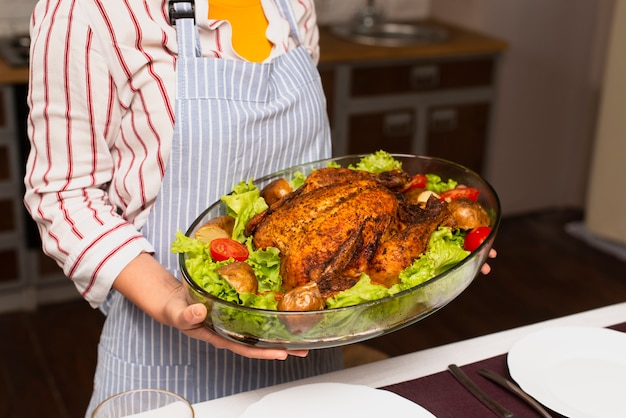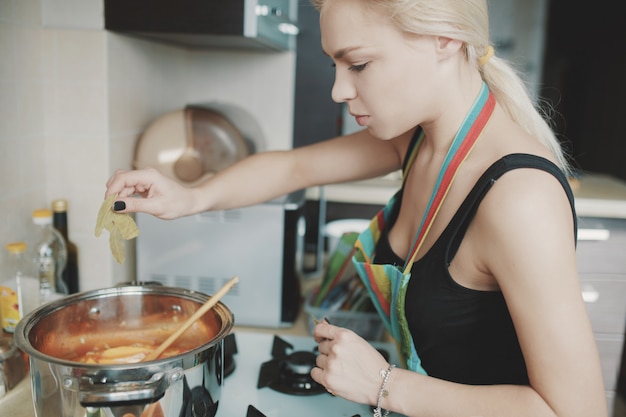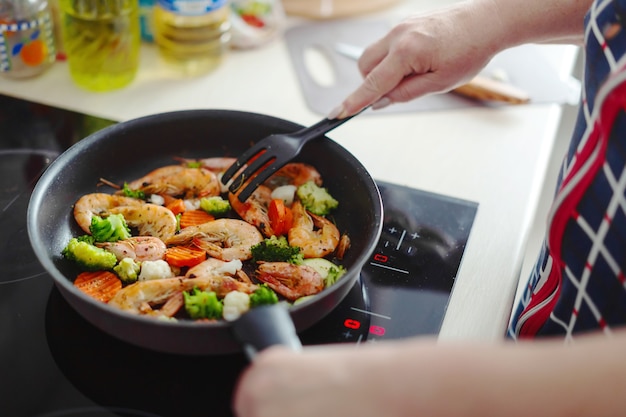There's something undeniably satisfying about cooking chicken on the stovetop. The sizzle of the pan, the tantalising aroma filling the kitchen – it’s a sensory experience that makes you feel like a culinary master. And honestly, it's a lot easier than you might think.
I've spent years perfecting my stovetop chicken game, and I'm ready to share my secrets. Whether you're a kitchen newbie or a seasoned chef, this guide will walk you through every step, from choosing the right cut to achieving that perfect crispy skin.
(Part 1) The Essential Toolkit

Before we dive in, let's make sure you've got the right equipment. Think of this as your culinary arsenal:
1. The Hero: The Pan
A good frying pan is the foundation of any stovetop chicken masterpiece. Cast iron is my go-to – it heats evenly and retains heat beautifully, resulting in that perfect sear. But stainless steel or even non-stick will work just fine.
2. The Oil: Your Flavor Base
Olive oil is a classic choice, but sunflower oil or even a blend of different oils adds depth of flavour.
3. The Must-Have: A meat thermometer
This little gadget is a lifesaver, ensuring your chicken is cooked through without being dry. Trust me, it's worth the investment.
(Part 2) Choosing the Right Chicken

The type of chicken you choose impacts the cooking time and texture of your dish.
1. chicken breasts: Lean & Juicy
Chicken breasts are the classic choice, versatile for grilling, pan-frying, or even baking. But they can be tricky – overcook them even slightly, and they become dry and tough. The key is to cook them quickly and carefully.
2. chicken thighs: Rich & Flavorful
Chicken thighs are my personal favourite. They're naturally juicier and more forgiving than breasts, due to their higher fat content. They're perfect for slow cooking, roasting, or pan-frying, and the flavour is rich and robust.
3. The "Skin-on" Decision
Skin-on chicken adds a delicious layer of flavour and crunch, but it can also make the chicken a bit greasy. If you're watching your fat intake, skinless is the way to go. However, don't toss out the skin! You can always remove it after cooking, and use it to make a delicious crispy snack.
(Part 3) Getting Ready to Cook

Before you even reach for the pan, take a moment to prepare your chicken. This simple step makes a big difference in the final result.
1. Pat it Dry
Using paper towels, pat your chicken dry. This removes excess moisture, allowing the skin to brown beautifully and creating a crispy texture.
2. Season it Right
Salt and pepper are a classic combination, but don't be afraid to get creative! Think about your favourite spices and herbs. Paprika adds a vibrant red colour and a slightly smoky flavour, while garlic powder lends a fragrant aroma.
(Part 4) The Classic Pan-Frying Method: Step-by-Step
This is the basic technique, a foundation for many stovetop chicken dishes.
Step 1: Heat the Pan
Place your pan over medium-high heat. Add a tablespoon or two of oil, and let it heat until it shimmers. You should see a faint wisp of smoke – this indicates the oil is ready.
Step 2: Add the Chicken
Carefully place the chicken in the pan. Don't overcrowd the pan, or the chicken won't brown properly. It's best to cook in batches if needed.
Step 3: Cook It Through
Cook the chicken for about 3-5 minutes per side, or until it's golden brown and cooked through.
Step 4: Check for Doneness
The golden rule: Never guess! Use a meat thermometer to ensure the internal temperature of the chicken reaches 165 degrees Fahrenheit (74 degrees Celsius). This guarantees it's safe to eat and juicy.
Step 5: Rest and Serve
Once the chicken is cooked, remove it from the pan and let it rest for 5-10 minutes before slicing and serving. This allows the juices to redistribute, resulting in a more tender and flavorful dish.
(Part 5) Achieving Crispy Skin: It's All About the Details
There's something undeniably satisfying about that perfect crispy chicken skin. Here's how to achieve it:
1. Dry It Out
Pat the chicken skin dry with paper towels. Any moisture will prevent it from getting crispy.
2. Salt It Up
Season the chicken skin generously with salt. This draws out moisture, promoting crisping.
3. Use Low Heat & Steam
After pan-frying for a few minutes, reduce the heat to low, cover the pan, and let the chicken steam for a few minutes. This allows the skin to cook slowly and become delightfully crisp.
4. Finish Strong
Uncover the pan, increase the heat to medium-high, and cook for another few minutes. This final step ensures the skin is perfectly crispy and golden brown.
(Part 6) Preventing Dry Chicken: A Cook's Best Friend
No one wants dry, rubbery chicken! Here are my tips to keep your chicken moist and delicious:
1. Don't Overcook
Overcooking is the biggest culprit. Once the internal temperature reaches 165 degrees Fahrenheit, your chicken is done! Don't keep cooking it beyond that point.
2. Trust the Thermometer
A meat thermometer is your best friend. It takes the guesswork out of cooking, ensuring your chicken is cooked through without being overcooked.
3. Add Moisture
If you're worried about dryness, add a splash of water or chicken broth to the pan. This creates steam, which helps keep the chicken moist.
(Part 7) Flavor Boosters: Elevating Your Chicken
Plain chicken can be a bit blah. Spice things up with these flavor-enhancing techniques:
1. Marinades: A Flavor Infusion
Marinating the chicken before cooking infuses it with flavor. Combine your favourite spices, herbs, and liquids like soy sauce, lemon juice, or wine. Let the chicken soak in the marinade for at least 30 minutes, or even overnight for maximum flavour.
2. Sauces: The Finishing Touch
A delicious sauce can make your chicken dish truly unforgettable. Try a creamy sauce, a tangy sauce, or a spicy sauce – the choice is yours!
3. Veggies: Flavor & Texture
Cooking your chicken with vegetables like onions, peppers, mushrooms, or even a few garlic cloves adds depth of flavour and creates a complete meal.
(Part 8) Serving Ideas: Beyond the Plate
Once your chicken is cooked, get creative with how you serve it!
1. Classic chicken dinner
Serve your pan-fried chicken with roasted vegetables, mashed potatoes, or rice for a hearty and satisfying meal.
2. chicken salad: A Refreshing Twist
Shred your cooked chicken and combine it with mayonnaise, celery, onion, and your favourite seasonings for a delicious chicken salad.
3. chicken tacos: A Flavorful Fiesta
Shred your cooked chicken and use it to make tacos. Top with salsa, sour cream, avocado, and your favourite toppings.
(Part 9) Exploring Different cooking techniques
Pan-frying is a classic method, but there are other ways to cook chicken on the stovetop:
1. Sautéing: Gentle Cooking
Sautéing is similar to pan-frying, but it uses lower heat. This allows the chicken to cook slowly, developing a more subtle flavour.
2. Searing: For a Crispy Crust
Searing involves cooking the chicken at very high heat for a short period of time. This creates a beautiful crust and locks in the juices.
(Part 10) Troubleshooting: Solving Common Issues
Even experienced cooks run into problems sometimes. Here's how to handle common stovetop chicken dilemmas:
Problem 1: Chicken Sticking to the Pan
This usually happens when the pan isn't hot enough. Make sure the pan is properly heated before adding the chicken.
Problem 2: Chicken Drying Out
Overcooking is the culprit! Use a meat thermometer to ensure your chicken is cooked through without being overcooked.
Problem 3: Chicken Not Browning
This could be due to the pan not being hot enough, the chicken being overcrowded, or not enough oil in the pan.
(Part 11) FAQs: Your Stovetop Chicken Questions Answered
What is the best type of oil to use for pan-frying chicken?
Olive oil or sunflower oil are excellent choices. They have a high smoke point, meaning they can withstand high heat without burning.
Can I cook frozen chicken on the stovetop?
It's not recommended. Frozen chicken will take longer to cook and may not cook evenly.
How long should I cook chicken on the stovetop?
The cooking time will vary depending on the thickness of the chicken and the heat of your stovetop. Generally, you'll cook for about 3-5 minutes per side.
How do I know if my chicken is cooked through?
Use a meat thermometer! The internal temperature should reach 165 degrees Fahrenheit (74 degrees Celsius).
What should I do with leftover cooked chicken?
Leftover chicken can be stored in the refrigerator for up to 3-4 days. Use it in salads, sandwiches, soups, or casseroles.
Conclusion: The Stovetop Chicken Master
cooking chicken on the stovetop is a simple yet incredibly versatile skill. By following these tips, you'll become a stovetop chicken master. Don't be afraid to experiment with different flavours, sauces, and cooking techniques – the possibilities are endless! Happy cooking!
Everyone is watching

Prime Rib Roast Cooking Time Chart: Per Pound Guide
Cooking TipsPrime rib roast. Just the name conjures images of lavish dinners, crackling fires, and hearty laughter. It’s ...

How Long to Bake Potatoes in the Oven (Perfect Every Time)
Cooking TipsBaked potatoes are a staple in my kitchen. They're incredibly versatile, delicious, and surprisingly easy to m...

Perfect Rice Every Time: The Ultimate Guide to Cooking Rice
Cooking TipsAs a self-proclaimed foodie, I've always been a bit obsessed with rice. It's the foundation of countless cuisi...

The Ultimate Guide to Cooking Asparagus: Tips, Techniques, and Recipes
Cooking TipsAsparagus. The mere mention of this spring delicacy conjures up images of vibrant green spears, crisp and burs...

Ultimate Guide to Cooking the Perfect Thanksgiving Turkey
Cooking TipsThanksgiving. Just the word conjures up images of overflowing tables laden with delicious food, the scent of r...
